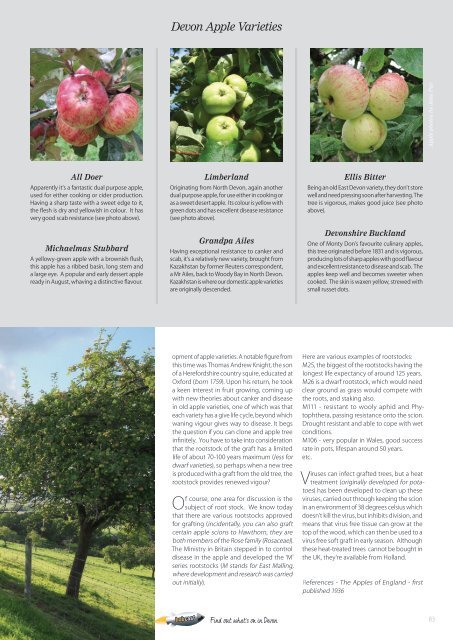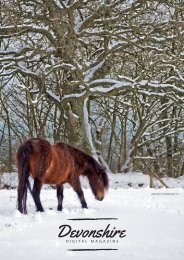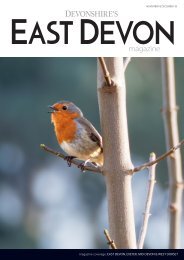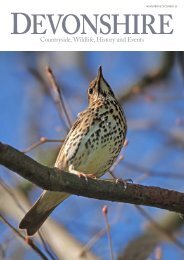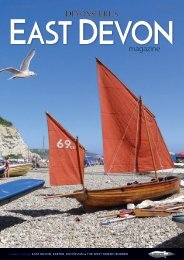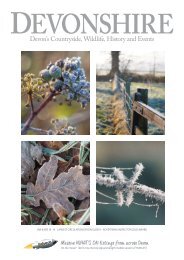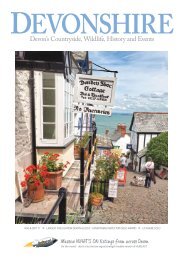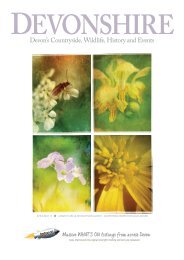Devonshire May and June 18
Create successful ePaper yourself
Turn your PDF publications into a flip-book with our unique Google optimized e-Paper software.
Devon GARDENING Apple Varieties<br />
Apple photos by Jane Pay<br />
All Doer<br />
Apparently it's a fantastic dual purpose apple,<br />
used for either cooking or cider production.<br />
Having a sharp taste with a sweet edge to it,<br />
the flesh is dry <strong>and</strong> yellowish in colour. It has<br />
very good scab resistance (see photo above).<br />
Michaelmas Stubbard<br />
A yellowy-green apple with a brownish flush,<br />
this apple has a ribbed basin, long stem <strong>and</strong><br />
a large eye. A popular <strong>and</strong> early dessert apple<br />
ready in August, whaving a distinctive flavour.<br />
Limberl<strong>and</strong><br />
Originating from North Devon, again another<br />
dual purpose apple, for use either in cooking or<br />
as a sweet desert apple. Its colour is yellow with<br />
green dots <strong>and</strong> has excellent disease resistance<br />
(see photo above).<br />
Gr<strong>and</strong>pa Ailes<br />
Having exceptional resistance to canker <strong>and</strong><br />
scab, it's a relatively new variety, brought from<br />
Kazakhstan by former Reuters correspondent,<br />
a Mr Ailes, back to Woody Bay in North Devon.<br />
Kazakhstan is where our domestic apple varieties<br />
are originally descended.<br />
Ellis Bitter<br />
Being an old East Devon variety, they don't store<br />
well <strong>and</strong> need pressing soon after harvesting. The<br />
tree is vigorous, makes good juice (see photo<br />
above).<br />
<strong>Devonshire</strong> Buckl<strong>and</strong><br />
One of Monty Don's favourite culinary apples,<br />
this tree originated before <strong>18</strong>31 <strong>and</strong> is vigorous,<br />
producing lots of sharp apples with good flavour<br />
<strong>and</strong> excellent resistance to disease <strong>and</strong> scab. The<br />
apples keep well <strong>and</strong> becomes sweeter when<br />
cooked. The skin is waxen yellow, strewed with<br />
small russet dots.<br />
opment of apple varieties. A notable figure from<br />
this time was Thomas Andrew Knight, the son<br />
of a Herefordshire country squire, educated at<br />
Oxford (born 1759). Upon his return, he took<br />
a keen interest in fruit growing, coming up<br />
with new theories about canker <strong>and</strong> disease<br />
in old apple varieties, one of which was that<br />
each variety has a give life cycle, beyond which<br />
waning vigour gives way to disease. It begs<br />
the question if you can clone <strong>and</strong> apple tree<br />
infinitely. You have to take into consideration<br />
that the rootstock of the graft has a limited<br />
life of about 70-100 years maximum (less for<br />
dwarf varieties), so perhaps when a new tree<br />
is produced with a graft from the old tree, the<br />
rootstock provides renewed vigour?<br />
Of course, one area for discussion is the<br />
subject of root stock. We know today<br />
that there are various rootstocks approved<br />
for grafting (incidentally, you can also graft<br />
certain apple scions to Hawthorn, they are<br />
both members of the Rose family (Rosaceae)).<br />
The Ministry in Britain stepped in to control<br />
disease in the apple <strong>and</strong> developed the ‘M’<br />
series rootstocks (M st<strong>and</strong>s for East Malling,<br />
where development <strong>and</strong> research was carried<br />
out initially).<br />
Here are various examples of rootstocks:<br />
M25, the biggest of the rootstocks having the<br />
longest life expectancy of around 125 years.<br />
M26 is a dwarf rootstock, which would need<br />
clear ground as grass would compete with<br />
the roots, <strong>and</strong> staking also.<br />
M111 - resistant to wooly aphid <strong>and</strong> Phytophthera,<br />
passing resistance onto the scion.<br />
Drought resistant <strong>and</strong> able to cope with wet<br />
conditions.<br />
M106 - very popular in Wales, good success<br />
rate in pots, lifespan around 50 years.<br />
etc.<br />
Viruses can infect grafted trees, but a heat<br />
treatment (originally developed for potatoes)<br />
has been developed to clean up these<br />
viruses, carried out through keeping the scion<br />
in an environment of 38 degrees celsius which<br />
doesn’t kill the virus, but inhibits division, <strong>and</strong><br />
means that virus free tissue can grow at the<br />
top of the wood, which can then be used to a<br />
virus free soft graft in early season. Although<br />
these heat-treated trees cannot be bought in<br />
the UK, they're available from Holl<strong>and</strong>.<br />
References - The Apples of Engl<strong>and</strong> - first<br />
published 1936<br />
hubcast<br />
.co.u k<br />
Find out what’s on in Devon<br />
83


